Water and Wastewater Engineering
Подождите немного. Документ загружается.

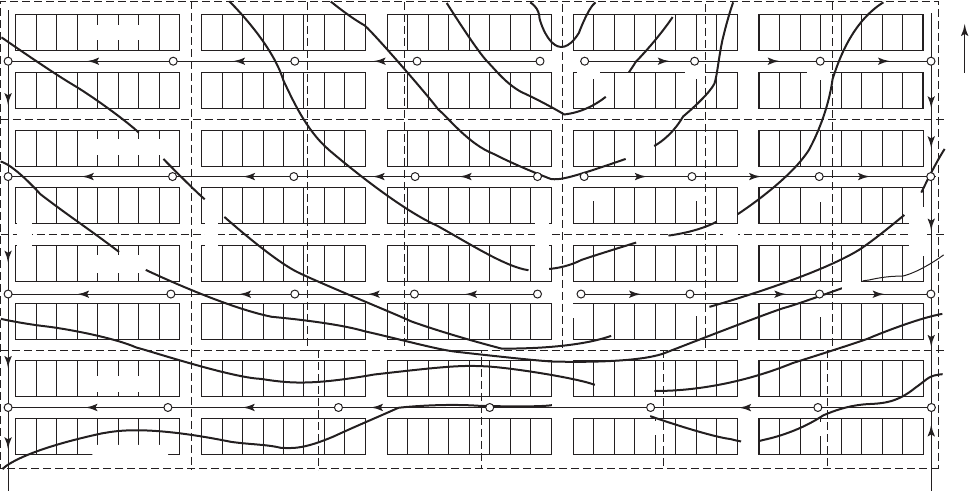
19-20 WATER AND WASTEWATER ENGINEERING
Layout of a Collection System
The collection system may be viewed as a dendritic network of sewers. The layout begins with
a detailed map that shows the contours. A line is drawn to represent the proposed sewer for each
street. An arrow is placed near the line to indicate the direction of flow. Except in special cases,
the sewers shou
ld slope with the ground surface. The plan that provides the m ost direct route is
often the most economical, provided that pumping is not required.
Manholes are located on the sewer lines in accordance with the design criteria for spacing.
Each manhole is numbered. The numbering system is
not prescribed. The author’s preference is
to have the lowest number at the termination of the system and the higher numbers at the extremi-
ties of the system, with sewage flowing from higher numbers to lower numbers.
The service area for each lateral is sketched on the map. Generally, the service area limits
will be midway between the streets where the sewer is to be place
d.
Figure 19-10 illustrates the layout technique.
Design of a Main
The design of a sewer main is the starting point for computations for a network. The flow chart
shown in Figure 19-11 provides an introd uction to the process. Experience and circumstances
will reveal a number of alternative methods for solving the problem.
41
43 44
19
18
17
16
4
3
2
1
12
11
21
23
24
34
31
92
91
94
98
97
96
95
96
13 th St.
11 th St.
42
32
33
22
Maple Ave.
Locust Ave.
Elm Ave.
15 th St.
Beech Ave.
Spruce Ave.
14 th St.
12 th St.
15
171
9
3
181
10 th St.
191
192
193
182
172
173
14
13
183
N
FIGURE 19-10
Layout of a sanitary sewer for a replacement project. The sewers are placed in alleys behind houses. The dashed lines indicate the service area for each
sewer. The contour lines are in meters. (Adapted from Steel and McGhee, 1979.)
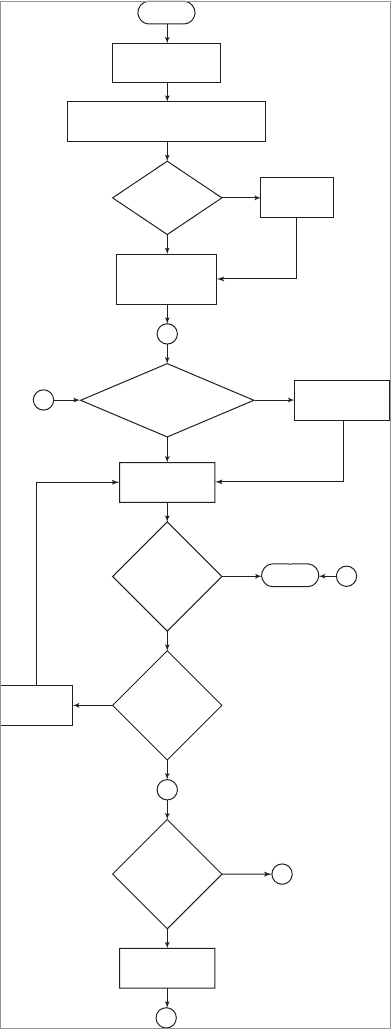
SANITARY SEWER DESIGN 19-21
Is
pipe
size >
200 mm
?
Decrease
pipe size
3
4
NO
YES
Start
YES
NO
Compute flow at
bottom of reach
Select pipe and slope that
will carry flow while flowing full
Select slope
ground surface
Select
200 mm
1
Is slope
< minimum slope ?
(Table 19–2)
Check velocity
for design flow
Select
minimum slope
YES
YES
YES
NO
NO
Increase
slope
Stop
4
2
3
Is pipe
< 200 mm
?
Is
velocity
okay ?
(! 0.6 m/s)
Is increase
in slope
reasonable
?
See Table 19–2
FIGURE 19-11
Sewer design flow chart for selecting pipe size for a reach between manholes.
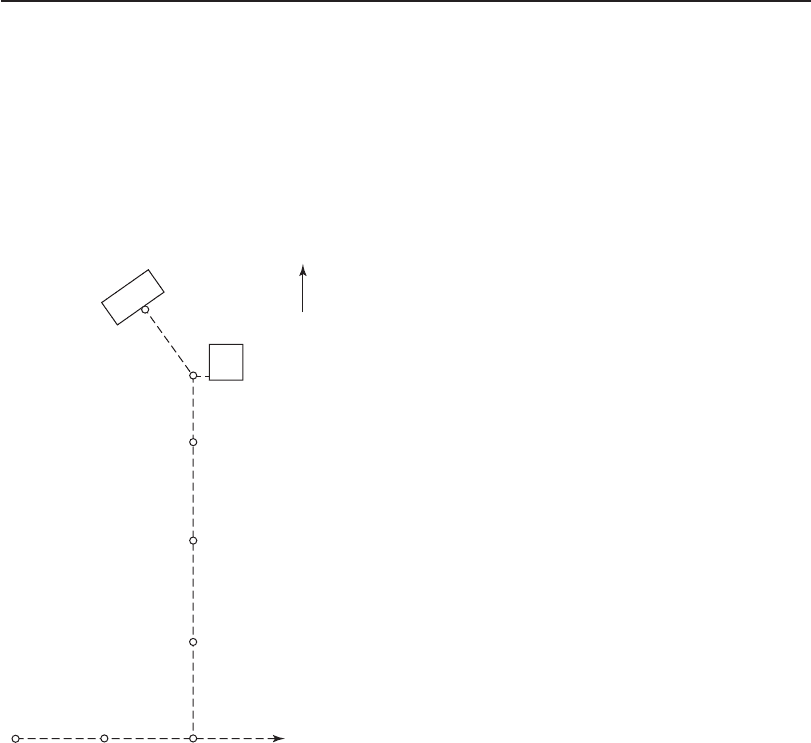
19-22 WATER AND WASTEWATER ENGINEERING
The check of the velocity at the design capacity is to evaluate whether or not the velocity at
the design flow rate will be self-cleaning.
The decision point in the flow chart that requires an evaluation of the question “Is increase
in slope reasonable?” requires some judgement and experienc e to make a choice. A beginning
criterion is that if the velocity is
less than or equal to 0.45 m/s, it is unlikely that increasing the
slope to achieve 0.6 m/s is reasonable. This is because the required slope will be so steep that it
will drive the sewer into the ground and ultimately require numerous lift stations. In the event
that the desired velocity cannot be achieved, the client s
hould be advised of the likelihood that
frequent cleaning will be required.
E xample 19-2 illustrates the design of a main.
Example 19-2. Design a s ewer to connect two businesses (Koffee Au Noir and Elsie’s Dairy
Kreamer) to an existing sewer main. The plan view of the proposed sewer line is shown in
Figure 19-12 . The distance between
manholes is m arked on the plan. It was selected bas ed on
an expectation that the sewer pipe diameter would be less than 375 mm. Surface elevations are
given at each manhole. The proposed sewer must connect to the existing sewer at MH No. 48 at
an invert elevation of 177.98 m. Assume that Koffee Au Noir and Elsie’s Dairy Kreamer both
have bas
ements. The peak flow rates for Koffee Au Noir and Elsie’s Dairy Kreamer are 20.2 L/s
MH 484
201.80
199.64
184.15
183.24
182.33
61 m 91 m 91 m 91 m
Elsie’s
Dairy Kreame
r
Koffee Au Noir
N
MH 485
MH 483
MH 482
MH 49MH 50 MH 48
MH 481
I.E. 177.98
76.2 m
201.10
FIGURE 19-12
Plan view of sewer for Example 19-2 . MH manhole . Elevations on the left of the MH are surface elevations.
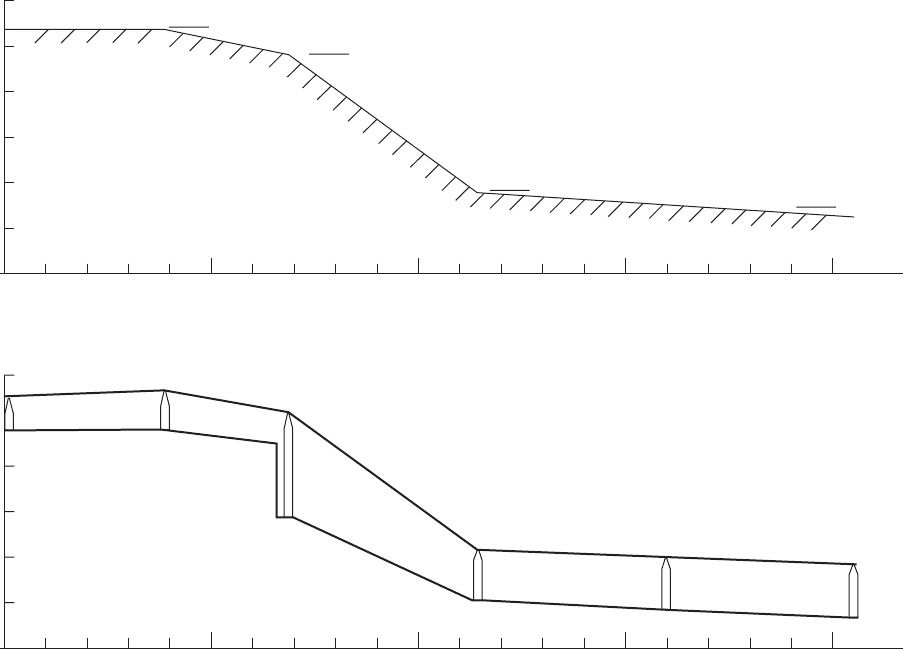
SANITARY SEWER DESIGN 19-23
and 14.5 L/s, respectively. Infiltration and inflow are assumed to be negligible for this sewer
main. A maximum velocity criterion of 2.5 m/s has been established by the local authority. No
other establishments will connect to this line above MH 482. VCP has been selected as the pipe
material. Ignore the customary 0.03
m drop through the manholes.
Solution:
a . Using the surface elevations from Figure 19-12 , plot the ground surface profile on a
scale drawing as shown in Figure 19-13 .
b. The calculations were performed on the spreadsheet shown below. Row and column
calculations are explained below the table.
c. The first four columns are self-explanatory.
205.0
200.0
Surface elev.
201.80
Surface elev.
199.64
Surface elev. 184.15
Surface elev.
182.33
195.0
190.0
185.0
180.0
175.0
0 00
(a)
1 00 2 00
Station, m
Elevation, m
3 00 4 00
205.0
MH 485
MH 484
MH 487
MH 482
MH 481
MH 48
I.E. 177.98
I.E. 179.39
3
00
mm
S
0.01
55
3
00
mm
S
0.0155
3
00
mm
S
0.09
33
I.E. 180.80
I.E. 189.29
S 0.0203
3
00
mm
200.0
195.0
190.0
185.0
180.0
Station, m
Elevation, m
Drop manhole
I.E. 197.53
I.E. 197.75
250 mm
S
0.0
029
Station, m
175.0
0 00
(a)
1 00 2 00
Station, m
3 00 4 00
FIGURE 19-13
Profiles for Example 19.2 . ( a ) Surface profile. ( b ) Sewer profile.
Note: drop through manhole has been ignored.

19-24 WATER AND WASTEWATER ENGINEERING
Example 19-2
Ground elevations
Line From MH To MH
Length of
line, m
Flow,
m
3
/s
Pipe
diameter,
m
Upper
MH, m
Lower
MH, m
Grade of
surface,
m/m
Grade of
sewer,
m/m
Velocity
flowing
full, m/s
(1) (2) (3) (4) (5) (6) (7) (8) (9) (10) (11)
1485 484 76.2 0.0202 0.250 201.10 201.80 0.0092 0.0029 0.65
2 484 483 61.0 0.0347 0.300 201.80 199.64 0.0354 0.0203 1.95
3 483 482 91.0 0.0347 0.300 199.64 184.15 0.1702 0.1702 5.65
3 revised 483 482 91.0 0.0347 0.300 199.64 184.15 0.1702 0.0933 4.18
4 482 481 91.0 0.0
347 0.300 184.15 183.24 0.0100 0.0155 1.70
5 481 48 91.0 0.0347 0.300 183.24 182.33 0.0100 0.0155 1.70
Notes: Drop through manhole (MH) was ignored. Column numbers (inparentheses) continue in the table on p. 19-25.
d. The flow rate in column 5, line 1 is the flow rate from Koffee Au Noir converted to
compatible units for later calculations:
20 2
1 000
0 0202
3
3
.
,
.
L/s
L/m
m /s
e. Column 6, line 1: Using Table 19-2 , select a 250 mm diameter pipe because it will carry
0.029 m
3
/ s flowing full at a minimum slope of 0.0025 m/m.
f. Columns 7 and 8, line 1: These are the surface elevations given on the plan map
( Figure 19-12 ).
g. Column 9, line 1: The ground slope is calculated using the two manhole elevations and
the distance between them:
201 10 201 80
76 2
0 0092
..
.
.
mm
m
The negative sign means that the slope is uphill.
h. Because the uphill slope is slight, the minimum slope from Table 19-2 for a 250 mm
diameter VCP pipe was selected and entered in column 10, line 1: 0.0025 m/m.
This slope resu lted in a velocity of 0.56 m/
s when flowing partially full. The slope was
adjus ted to 0.0029 m/m to achieve a velocity of 0.60 m/s when flowing partially full.
i. Column 11, line 1: Using Equation 19-6 because the pipe is flowing full, the velocity at
a slope of 0.0029 m/m and a Manning’s n 0.013 is:
v
n
DS
0 397
0 397
0013
02500
2 3 12
2 3
.
.
.
.
()
()(
//
/
m ..
.
0029
065
12
)
/
m/s
Note: Manning’s n 0.013 because the pipe is new VCP.

SANITARY SEWER DESIGN 19-25
j. Column 12, line 1: Using Equation 19-7 because the pipe is flowing full, the flow rate at
a slope of 0.0029 m/m and a Manning’s n 0.013 is:
Q
n
D S
0 312
0 312
0 013
025 000
83 12
83
.
.
.
..
()
()(
//
/
229
0 0321
12
3
)
/
m /s .
k. Column 13, line 1: computation of Q / Q
full
using Q from column 5 and Q
full
from
column 12:
0 0202
00321
063
.
.
.
l. Colu mn 14, line 1: Using Figure 19-9 and the procedure outlined in step c in
Example 19-1 , find v / v
full
:
v
v
full
092.
m. Column 15, line 1: Calculate the velocity for the pipe flowing 92 percent full:
v
full
m/sm/s()( )092 065 060.. .
Note: The ratio (0.92) was computed in column 14, and the velocity was computed in
column 11.
n. Column 16, line 1: Calculate the change in elevation from the upper MH to the lower
MH (called the fall ) using the distance between manholes from column 4 and the slope
from
column 10:
()( )76 2 0 0029 0 22.. .mm/mm
Invert elevations
Q
full
,
m
3
/s Q/Q
full
v/v
full
Velocity,
m/s
Fall of
sewer, m
Upper
MH, m
Lower
MH, m
Depth
of lower
MH, m
(12) (13) (14) (15) (16) (17) (18) (19)
0.0321 0.63 0.92 0.60 0.22 197.75 197.53 4.27
0.1379 0.25 0.71 1.38 1.24 197.53 196.29 3.35 Picked depth of 3.35 m and
calculated slope of 0.0203
0.3993 0.09 0.52 2.94 15.49 196.29 180.80 3.35
0.2957 0.12 0.58 2.42 8.49 189.29 180.80 3.35 Drop MH
7.0 m
0.1205 0.29 0.72 1.23 1.41 180.80 179.39 3.85
0.1205 0.29 0.72 1.23 1.41 179.39 177.98 4.35

19-26 WATER AND WASTEWATER ENGINEERING
o. Column 17, line 1: The elevation of the upper MH is the difference between the surface
elevation and the invert of the sewer, which is 3.35 m below the ground surface because
Koffee Au Noir and Elsie’s Dairy Kreamer have basements (see Table 19-4):
201 10 335 197 75.. .mm m
p. Column 18, line 1: The elevation of the lower MH invert is the difference between the
upper MH invert (column 17) and
the fall (column 16):
197 75 0 22 197 53.. .mm m
Note: This elevation is copied to column 17, line 2.
q. Column 19, line 1: This column is a check to make sure that the depth at the lower MH
is equal to or greater than the required depth for basements. It is calculated as the surface
elevation (column 8) minu
s the invert of the lower MH (column 18):
201 80 197 53 427...mmm
Now working on Line 2
r. Column 5, line 2: The flow rate is the sum of that from Koffee Au Noir and Elsie’s Dairy
Kreamer:
0 0202
14 5
1 000
00347
3
3
3
.
.
,
.m /s
L/s
L/m
m /s
Note: Because there are no additional flows for the remainder of the lateral, this flow
rate is repeated in the remaining lines of this column.
s. Column 6, line 2: Because 0.0347 m
3
/ s is greater than the flowing full capacity of the
250 mm diameter pipe at the minimum slope, use Table 19-2 and select a 300 mm diam-
eter pipe to carry the flow.
t. Column 10, line 2: Because the slope is steep, a trial calculation places the invert eleva-
tion of the lower MH at the minimum depth of 3.35 m. The logic in making this
choice
was to minimize excavation. Thus, the invert elevation at MH 483 is:
199 64 335 196 29.. .mm m
The lower MH elevation is then entered in column 18.
The slope is then computed from the invert elevations in columns 17 and 18 and the
distance between the MHs (column 4):
197 53 196 29
61 0
0 0203
..
.
.
mm
m
u. Columns 11 through 19, line 2: follow the same logic as in line 1.
Now working on Line 3
v. Columns 1 through 9: follow the logic in lines 1 and 2. Note that the distance in column 4,
MH 483 to MH 482, is the horizontal distance. This is the distance to calculate the slope.
The actual required
pipe length is obviously longer.

SANITARY SEWER DESIGN 19-27
w. Column 10, line 3: The slope of the ground surface was selected for this trial.
x. Columns 11 through 19, Line 3: follow the same logic as in Line 1.
Note: The velocity in column 15 exceeds the allowable velocity of 2.5 m/s.
Now working on Line 3 revised
y. Because of the excessive velocit
y, a drop manhole at MH 483 was selected to reduce the
slope of the sewer. After several trials, using the velocity criterion of 2.5 m /s to deter-
mine acceptability, a drop of 7.0 m was selected. The upper MH elevation is:
196 29 7 0 189 29.. .mm m
z. Column 10, line 3 revised: Keeping the lower MH elevation at the same value as in the
first trial for line 3, the slope i
s then:
189 29 180 80
91 0
00933
..
.
.
mm
m
aa. Columns 11 through 19 for line 3 revised are calculated as in Line 1.
bb. Lines 4 and 5: Because the grade is uniform from MH 482 to MH 48, the slope was com-
puted from the invert at MH 482 to the invert specified for connection at MH 48, that is,
177.98 m. It is
180 80 177 98
2910
00155
..
.
.
mm
m
()
Note: The factor of 2 in the denom inator is to account for the two manhole distances
between MH 482 and MH 48.
cc. Assuming that the slope remains constant, it is entered in column 10 for lines 4 and 5. The
computations in columns 11 through 19 for lines 4 and 5 are calcu
lated as in line 1. The
depth of the lower MH is checked to make sure that it is equal to or greater than 3.35 m. This
satisfies the requirements for the sewer and completes the computations for this lateral.
dd. The final sewer profile is shown in Figure 19-13b .
Comments:
1 . The long, tedious explanation belies the ease with which the comp
utations and design
may be completed with the aid of a spreadsheet. The length of the solution is also exac-
erbated by several issues that were introduced to provide an example for instructional
purposes.
2. The weakness of the spreadsheet s olution used here is that it requires the user to
determine the v / v
full
ratio graphically. A complex polynomial equation can be resolved
to fit a large portion of the graphical solution.
3. This solution is only one of several alternatives. Some others include the following:
a . On a larger scale, another route that does not include the steep grade m ay be
available.

19-28 WATER AND WASTEWATER ENGINEERING
b. The selection of the diameter of the sewer based on the minimum slope introduc ed
some complexities that may be avoided by picking a smaller diameter pipe placed at
a steeper grade from the starting point at Koffee Au Noir.
c. A gravity force main may be a more economical alternative.
4. F
rom a construction point of view, microtunneling may be a cost-effective alternative
to conventional excavation for construction. As a general rule, microtu nneling is often
cost effective when the depth of cover is equal to or greater than 7.5 m. Trenchless con-
struction is not always effective with high ground water as there is still a need to handle
the water. No
minal drive lengths are 90 to 215 m (Staheli and Hermanson, 1996). Other
trenchless methods, such as jack and bore, may be more appropriate than microtunneling.
Directional drilling is not typically used for gravity flow sewers because of the lack of
grade control. It may be appropriate for building services.
5. As
with water distribution systems, commercially available computer programs provide
rapid solutions for large pipe networks. In the more sophisticated programs, there are
optimization routines that lay out routing based on specified criteria as well as perform-
ing all the calculations.
Final Drawings
Computer-aided design (CAD) facilitates the preparation of final drawings. CAD draw-
ings are often used in conjunction with aerial photogrammetry to produce the final drawings.
Figure 19-14 is an example of a typical drawing.
19-4 ALTERNATIVE SEWERS
The most common alternative sewer systems are small-diameter gravity (SDG), pressure, and
vacuum sewers. Although these systems are predominately used for very small, remote areas
providing service to populations less than 200 people, they have found special application
with signific antly larger populations (Gu
ertin, 2007). The following paragraphs compare these
systems and outline their design. For detailed guidance on their design the reader is referred to
the Water Environment Federation publication entitled Alternative Sewer Systems (WEF, 1986)
and commercial literature from companies supplying these systems.
System Descriptions
Small-Diameter Gravity (SDG). The SDG sewers may be either constant gradient or variable
gradient. Both use small diameter pipes to carry septic tank effluent to a treatm ent facility. The
septic tanks are an essential part of the system as they provide a plac e for removal of heavy
solids, grease, and grit that would otherwise plug the pipe.
The advantages of SDG sewers over
conventional sewers include lower capital cost because
of reduced pipe and installation costs; clean-outs instead of manholes; reduced lift station costs
because of pretreatment and flow attenuation by the septic tanks; and reduced I/I. Another
potential advantage is red
uction in treatment costs because of septic tank pretreatment. Disad-
vantages of SDG sewers include maintaining and pumping the septic tanks, odors, and corrosion
because of the anaerobic conditions in the septic tank that result in hydrogen sulfide production.
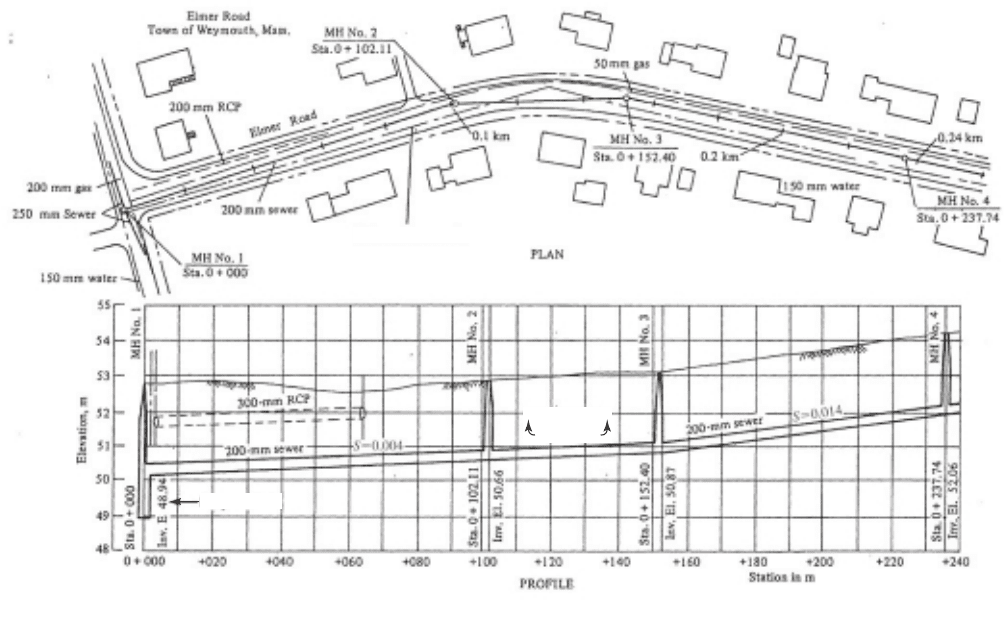
SANITARY SEWER DESIGN 19-29
Pressure Sewers. The two major types of pressure sewer systems are the septic tank effluent
pump (STEP) system and the grinder pump (GP) system. The STEP system, like the SDG system,
requires a septic tank for the same reasons as the SDG system. The GP system grinds the solids in
a small tank on the residence property and pumps the wa
stewater into the pressure pipe system.
The benefits of pressure sewers primarily relate to installation costs because the sewer uses
small diameter pipe that is laid just below the frost penetration depth. Some site conditions par-
ticularly favor pressure pipe systems. These include hilly terrain, rock outcropping, high water
tables, an
d lakefront property that lacks a natural slope for a gravity sewer. Because the pipe is
pressurized, I/I is not a problem.
Potential disadvantages include higher operation and m aintenance cost because of the need
to maintain the numerous pumps in the system. Severe corrosion of the electrical and mechanical
equip
ment, particularly from the STEP system, may be encountered.
Vacuum Sewers. These systems depend on a central vacuum source. A valve is used to
separate the gravity portion of the waste system from the vacuum at the source. When the valve
opens, a slug of wastewater followed by a slug of air enters the pipe system. The
slug of waste-
water is propelled into the main by the differential pressure of the vacuum and the air slug. The
Drop manhole
150 mm water main
Water main
00
FIGURE 19-14
T ypical sewer contract drawing. (Adapted from Metcalf & Eddy, 1981.)
